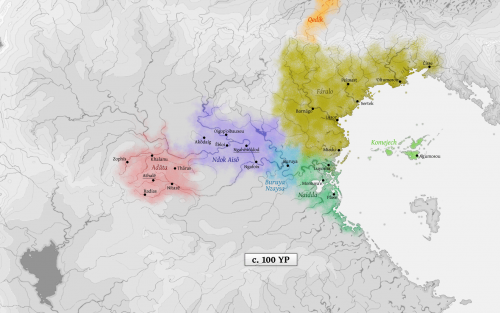Edastean languages
The Edastean language family (from Fáralo Edástə, "Ndak Ta") encompasses Ndak Ta and the large number of tongues descended from it. These are the principal languages of the cultural sphere centered on the Aiwa valley. Edastean is itself a branch of the larger Macro-Edastean Family. Currently known direct descendants of Ndak Ta are:
- Adāta, native to the Rathedān highlands, with its numerous descendants, the Dāiadak Languages, spread in every direction by the conquests of the Empire of Athalē
- Ndok Aisô, native to the original Ndak homeland of Lasomo
- Naidda, the language of Kasca (the areas in and around the Aiwa Delta) which was the center of Ndak civilization
- Buruya Nzaysa, the speech of Buruya on the lower Aiwa. It is traditionally classified as a divergent dialect of Naidda, but considered to be a separate language by some scholars.
- Fáralo, spoken in the areas to the north of Kasca, and the language of the Empire of Huyfárah
- Komejech, spoken in the Dagæm Islands
- Qedik, spoken on the coast north of the Northern Mountains
Fáralo and Adāta, the languages of the two great Edastean empires of the Classical Era, are believed to be the most influential in the long term - though this is disputable, until more information on the second millennium YP is available. Descendants of Naidda are known to become a major force by 1500 YP or so.
The family was created by members of the ZBB in the course of two different conlang relay games.
The first one, a reconstruction relay, was begun in 2005. Two teams each derived five daughter language sketches from one protolanguage, which was then to be reconstructed by the other group. Starting from Radius Solis' Ndak Ta, Team Two of this game created Adāta, Fáralo, Naidda, Ndok Aisô, and Qedik.
The second relay, which started in the summer of 2006, took Dewrad's Adāta language as a starting point and set out to create several long branches of the language family, the longest of which has reached its 8th generation. This relay game has given way to a free-form development of new languages and cultures, open to all; this was the genesis of Akana as a full-scale collaborative conworlding project.
The Tsinakan text is the Babel Text of Edastean studies. Translations will be posted at the linked page when available.
A poster portrait of the Edastean languages is also available.
Tree of the Edastean language family
- Ndak Ta (Eigə valley, c. -1800 YP - Radius Solis)
- Western Edastean languages:
- Ndok Aisô (Lasomo, c. 0-200 YP - v2.0 by Dunomapuka and Cedh, v1.0 by ghur [1])
- Dāiadak languages: Adāta (Rathedān, c. 0-200 YP - Dewrad)
- Lasomoran languages: Æðadĕ (Lasomo, c. 1000 YP - ebilein)
- Athalēran languages:
- Aθáta (Rathedān, c. 1000 YP - RHaden)
- Arâta Sawîyaran (Thabīa valley, c. 1000 YP - Cedh - classified as a dialect of Aθáta)
- Tharāran languages: Ayāsthi Thāraspē, c. 1600 YP - Zhen Lin - v1.0 here)
- Khalanuran languages: Mavakhalan (Khalanu, c. 1000 YP - Zhen Lin)
- Ājat he-Heloun (Khalanu, c. 1700 YP - 4pq1injbok)
- Koyic languages:
- Kuyʔūn (Eiwəl Gourun, c. 1200 YP - Cedh)
- Pencek (western Ici Forest, c. 1100 YP - Radius Solis)
- Eastern Edastean languages:
- Naidda (Kasca, c. 0-200 YP - Radius Solis - v1.0 here {broken link → backup})
- Neire Wippwo (Kasca, c. 1500 YP - Arzena)
- Buruya Nzaysa (lower Eigə valley, c. 200-400 YP - Cedh, Dunomapuka - classified as a dialect of Naidda)
- Fáralo languages: Fáralo (Huyfárah, c. 0-200 YP - zompist)
- Puoni (eastern Ici Forest, c. 1100 YP - Radius Solis)
- Namɨdu (southern Huyfárah, c. 1100 YP - Dunomapuka)
- Nåmúþ (southern Hufárah and northern Kasca, c. 2000 YP - Dē Graut Bʉr)
- Farwo n-Abebbu (Azbǽbu, c. 1100 YP - Cedh - classified as a dialect of Namɨdu)
- Fallo na Mendia (Mæmedéi, c. 1100 YP - thedukeofnuke - classified as a dialect of Namɨdu)
- Woltu Falla (Oltu valley, c. 1100 YP - thedukeofnuke)
- Cəssın (Isthmus south coast, c. 1100 YP - Cedh)
- Komejech (Dagæm islands, c. 0-200 YP - Legion)
- Naidda (Kasca, c. 0-200 YP - Radius Solis - v1.0 here {broken link → backup})
- Northern Edastean languages:
- Qedik (Isthmus north coast, c. 0-200 YP - Space Dracula)
- Western Edastean languages:
Features
Western Edastean common features
- Evolution of a third row of occlusives from NT nasal + stop.
- Only one sibilant place of articulation.
- Only one phonemic semivowel.
- Preservation of a more complex verbal morphology (moods, passive voice).
- No person marking on verbs.
- Loss of the article.
- Shift to SVO word order.
- Outcome of bʷ is backed (to /z/ in Adāta, /ɡ/ in Ndok Aisô).
Eastern Edastean features
- Two rows of occlusives.
- Sibilants at two different places of articulation.
- Two phonemic semivowels.
- Consonantic mutations (Fáralo and Komejech).
- Simplification of the verbal complex, compensated by development of an auxiliary verb system.
- Enclitic pronouns, to the verge of polypersonal agreement on (auxiliary) verbs (Fáralo and Naidda).
- Inflected prepositions (Naidda and Komejech).
- Preservation of articles.
- Preservation of VSO word order.
- Outcome of bʷ retains a labial obstruent (Fáralo and Naidda).
Note: These generalizations apply principally to first-generation daughters of Ndak Ta, and are often not reflected in subsequent generations. For example, many of Adāta's descendants have multiple sibilant articulations, and some of Fáralo's have only one. Also, Buruya Nzaysa patterns as an Eastern Edastean language grammatically, but shares some phonetic developments with Ndok Aisô (e.g. only one sibilant articulation; /ɡ/ as the regular reflex of word-initial bʷ and word-medial mbʷ).
